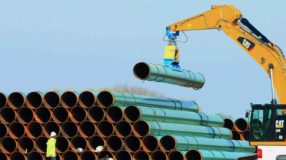Pipeline Safety Facts
The interstate natural gas pipeline industry operates under clear regulations and robust safety standards that govern the design, construction, materials, operation and maintenance of all natural gas transmission pipelines.
- This industry benefits greatly from clear regulations and robust safety standards that have been in place for decades and that cover the entire life cycle of pipelines.
- We cannot speculate on what occurred in San Bruno, California, but as an industry, we have a strong interest in ensuring the highest level safety throughout the entire natural gas delivery chain.
- U.S. interstate natural gas transmission pipelines are rigorously regulated by three federal agencies: the Department of Transportation’s Pipeline and Hazardous Materials Safety Administration (PHMSA); the Federal Energy Regulatory Commission (FERC); and the Transportation Security Administration’s Pipeline Security Division.
- PHMSA is the primary safety regulator of the interstate natural gas transmission pipeline system.
- PHMSA’s regulations and safety standards address a variety of issues affecting pipeline safety, including pipe and component manufacture, how pipelines are built, operated, maintained and inspected, how personnel are trained, how companies respond to emergencies and much more.
The interstate natural gas transmission pipeline system is among the safest modes of transportation in the nation.
- Based on recent U.S. Department of Transportation data, pipelines are the safest way to transport large quantities of energy products over long distances; significant incidents have declined by over 30 percent from 1998 – 2008.
- Over 320,000 miles of natural gas transmission pipelines safely and reliably transport 25 percent of the nation’s total energy consumption that is ultimately delivered to more than 70 million U.S. consumers.
- The safety performance of the interstate natural gas pipeline system is constantly analyzed and this analysis is used to further improve safety performance.
- The interstate natural gas transmission pipeline industry’s outstanding safety record is the end result of many different processes that are incorporated into individual pipeline systems and then monitored for safety.
- The industry is steadfastly committed to working with local communities and has developed public awareness programs to educate local communities along pipeline rights of way about natural gas transmission pipelines.
- The tragic event in California underscores the importance of continued focus on safety.
To further enhance public safety, in 2003 PHMSA created the Integrity Management Program for natural gas transmission pipelines that is designed to verify the safety of pipeline segments located in populated areas.
- Industry integrity management and safety programs often exceed regulatory requirements and are designed to detect anomalies, perform repairs and prevent pipeline failures.
- The Integrity Management Program has been very effective in further assuring pipeline safety in populated areas.
Excavation damage continues to be a leading cause of fatalities and injuries associated with pipeline incidents.
- Third-party digging near pipeline facilities is the number one cause of natural gas transmission accidents that result in fatalities and/or injuries.
- Federal and state laws support excavation damage prevention systems that assist third-party contractors to locate underground facilities before they dig.
- It is vital that excavators make the appropriate contacts before they dig in the vicinity of pipelines.
- Many excavation damage prevention programs still exempt certain classes of excavators and/or underground utilities; these exemptions should be eliminated in order to achieve maximum damage prevention. And, in some cases, the effectiveness of these programs would be improved by more rigorous state enforcement.
Natural gas is a vital component of North America’s energy supply.
- North America requires a varied mix of energy sources to serve a growing economy, population and the desire for clean energy.
- Natural gas plays an important role in that mix, accounting for about 25 percent of energy consumption in the U.S.
- Natural gas is:
- The cleanest-burning conventional source of energy.
- Domestically abundant, with more than a century of supply.
- Reliable, available 24/7, regardless of weather conditions.
- Versatile. It heats and cools homes, powers industry, generates electricity (including low-emission backup for weather-dependent renewable electric generators), and fuels transportation.







